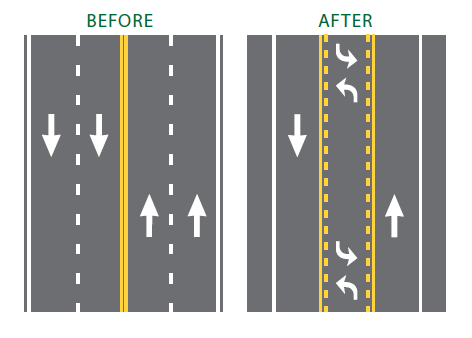Four to Three-Lane Conversion/Three-Lane Roadway/Road Diet
What is a four to three-lane conversion or road diet?

Illustration of the before and after of a four to three-lane conversion or road diet.
Image source: FHWA
A four to three-lane conversion, also known as a road diet, means converting a four lane undivided road into a three-lane undivided road that consists of two through traffic lanes and a two-way left-turn lane (TWLTL) in the center.
Many state transportation departments, cities and counties in small communities and large cities are taking advantage of this design because of the proven safety benefit when compared to four-lane undivided highways.This can be a low-cost safety solution when only pavement marking changes are needed.
Learn more about four to three-lane conversions/road diets.
Benefits include:
- crash reduction
- fewer rear-end and left-turn crashes
- fewer lanes for people walking to cross
- provides space for bicycle lanes, street parking, bus stops, curb extensions or other uses
- simplifies left turns from side streets
- smoother traffic flow
- less lane switching
- when done as part of a reconstruction there are many positive uses for the space created
Documents
Case studies in Minnesota
- Albert Lea: Highway 65/South Broadway Avenue
- Battle Lake: Highway 78/Lake Avenue
- Parkers Prairie: Highway 29
- Richfield: Sweet Streets Program
- St Paul: Maryland Avenue
- Star Tribune article on 4 to 3 lane reconfigurations, June 8, 2019
Examples in Minnesota
- Hwy 27 in Little Falls
- Hwy 95 in Cambridge
- Lexington Avenue in Roseville
- Bass Lake Road, Brooklyn Center/Crystal
- Hwy 2 in Floodwood
- Hwy 7 in Silver Lake
- Hwy 19/Bridge Street, in Redwood Falls
- 86th Street and 90th Street in Bloomington
- Hwy 61 in Two Harbors
- Hwy 10 in Wadena

